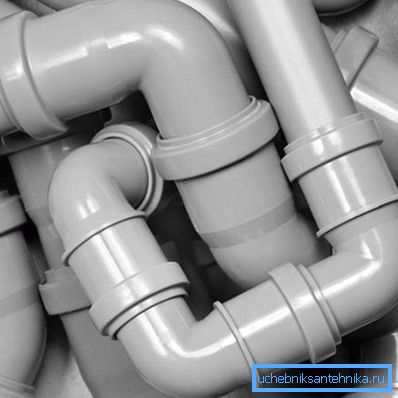Fitting for pvc pipes: an economical option for mounting
PVC pipes and fittings for plumbing and sanitary today are used almost everywhere. This material is preferred for use by novice craftsmen, since its processing is not particularly difficult, and the hermetic connection can be carried out in many ways.

Below we describe the features of such products, as well as analyze their positive and negative qualities.
Fitting Analysis
Material
A fitting is a part of a pipeline that is used to connect straight pipes, as well as the formation of pipe wiring by arranging turns, branches, installation of valves, etc.
For the manufacture of fittings used a variety of polymeric materials, and polyvinyl chloride is one of the most common.

The composition of PVC includes the following components:
- The foundation - polyvinyl mass with high plasticity. Due to its performance characteristics, the fitting acquires resistance to deformations arising from its use in the system.
- Hardener - a material that reduces viscosity and increases the density of PVC. The more hardener will be in the composition, the stronger will be the walls of the connecting element.
- Plasticizer - component that gives PVC elasticity. With a lack of plasticizer, the product becomes brittle and cracks at the slightest bending or tensile structure.
Note! Also in the composition of polyvinyl chloride can be injected pigments, but the pipes and fittings are usually produced in neutral gray. However, there are exceptions, especially among branded products.
Key varieties
Due to such characteristics of the material, the instruction provides for the possibility of several options for arranging the pipe-fitting connection.
By this parameter, all the details are divided into:

- Glue - adapters for various pipes that provide permanent fixation using special glue. Under the condition of manufacturing according to the standards, the parts fit into each other with a minimum gap, and the use of molecular glues makes the contact area completely sealed. The maximum allowable for such fittings is a pressure of 160-170 bar (the value depends on the water temperature and the diameter of the pipes).
- Threaded - are connected using a male threaded nozzle and a nut (metal or polyvinyl chloride). Usually made from more rigid PVC with a lower coefficient of elasticity, thereby maintaining a high density of the threaded connection.

- Combined - involve both the use of a cap nut on the thread, and sizing the pipe. Used where it is necessary to ensure maximum mechanical strength and increase tightness.
- Detachable - are joined to the pipes using elastic rubber couplings. Such compounds do not withstand high pressure, because they are most often used in the construction of gravity (free-flow) sewage systems.
Fittings for PVC water pipes can also have a very different configuration. Examples of the most commonly used parts are given in the table below:
| Title | Configuration features and purpose |
| Nipple | Can be both plastic and metal. Used for joining two pipes of different diameter. Most often for this purpose a threaded connection is used. |
| Clutch | Short pipe segment with sockets at both ends. Couplings use to build pipes of the same diameter. Almost always assume adhesive bonding. |
| Tap | It is a piece of pipe with a side branch. Usually, tightness is ensured by using an adhesive belt, but fittings for sewer systems can also be supplied with a rubber sealing sleeve. Used to form piping. |
| Angle | Plastic part, devoid of metal parts. It is installed where it is necessary to form a turn of the pipe without changing the diameter. Connection methods are similar to those described in the previous paragraph. |

However, in some cases other configurations of fittings can be used, since their range is constantly expanding.
Features of use
Benefits
The popularity of PVC parts is due to the fact that they are characterized by quite tangible advantages.
Among the advantages of PVC fittings are the following:
- Chemical Resistance. Parts are not subject to corrosion, polyvinyl chloride for a long time retains elasticity, ensuring the tightness of the connection.
- Light weight Pipe wiring exerts a minimum load on the supporting structure, which allows it to be mounted almost anywhere.

- A variety of models. Without difficulty, you can find a fitting for any diameter pipes and for any configuration wiring.
- Easy do-it-yourself installation. Plastic is easily processed, and complex tools are not required for the compound: there is enough file for stripping edges and PVC glue.
- Affordable price.

disadvantages
As for the cons, they are also present.
And even though they cannot be called fatal, it is necessary to remember them:
- First of all, PVC is characterized by relatively low resistance to shock loads. With a strong impact, both the pipe and the fitting can crack, causing leakage.
Note! The fragility of polyvinyl chloride increases with a decrease in temperature, because the external pipelines necessarily require insulation.
- Secondly, High elasticity of the material may cause a leak in the joint between the fitting and the pipe. To avoid this, it is necessary to fix all the details on the supporting structures (the easiest way to do this with the help of brackets) and to eliminate bending loads.
However, if we take into account these moments, then unpleasant consequences can be avoided.
Conclusion
PVC pipes and fittings can rightly be considered consumables:
- they are inexpensive;
- easy to handle;
- but at the same time provide the required quality of laying communications.
Of course, for the result to be what we need, we should strictly follow the rules for connecting parts, but with this we will be helped by the advice given in the text, as well as in the video in this article.